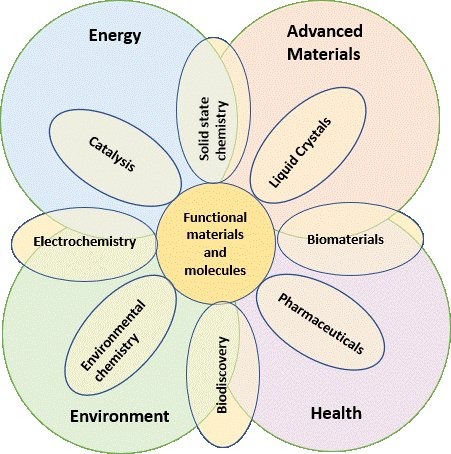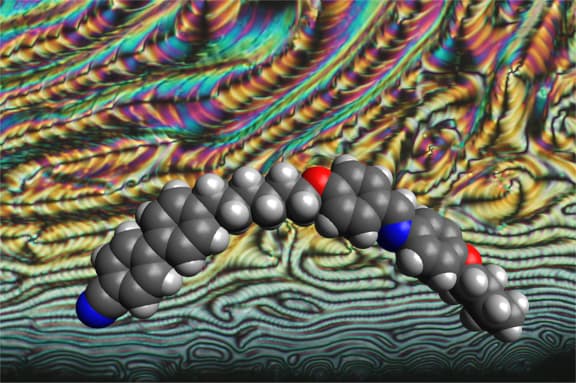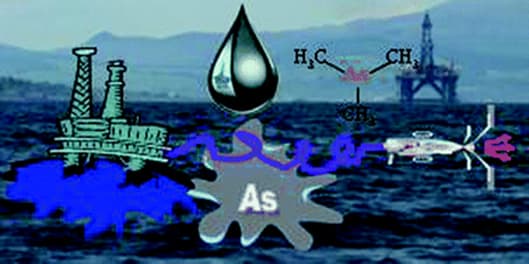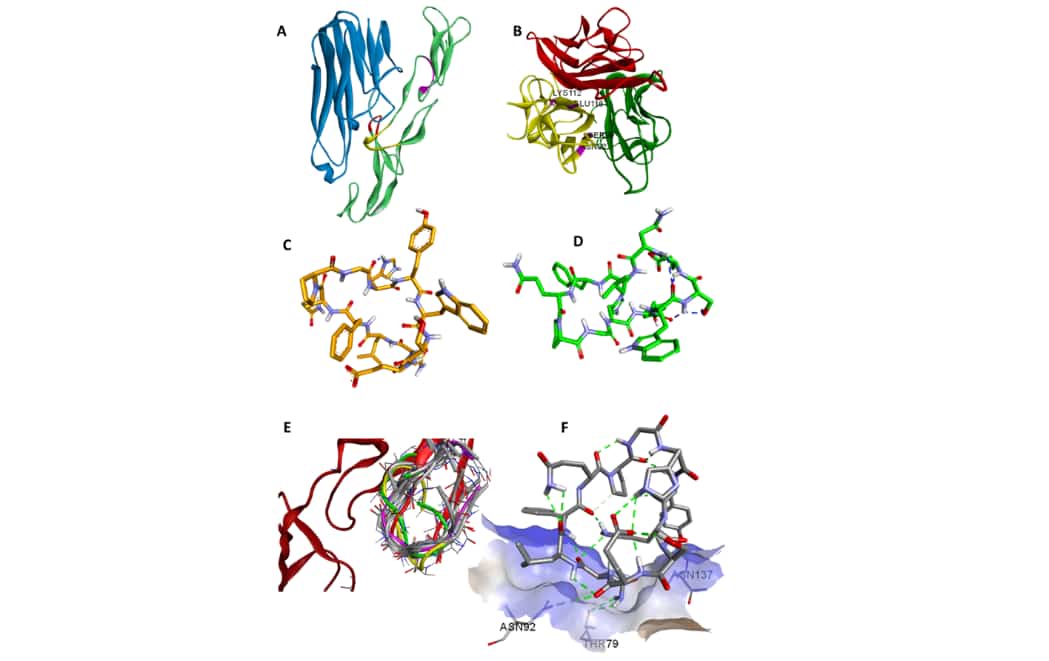95% of Chemistry research at Aberdeen was ranked as world-leading or internationally excellent by REF 2021
The Department of Chemistry at the University of Aberdeen is an outward looking and vibrant department with strong international collaborative links and prestige.
We engage and work with multiple partners (academic and industry) to enhance the impact of our research and have been highly successful in obtaining funding from a range of sources.

Research Themes
There are four main themes to our research:
- Advanced Materials
-
The Advanced Materials theme brings expertise in materials synthesis, characterization and modelling to tackle important challenges in liquid crystals, electrical and magnetic materials and biomaterials.

Research groups in this area:
- Energy
-
Research is focussed on the synthesis and investigation of sustainable materials for photocatalysis, heterogeneous catalysis, energy conversion and storage.

Research groups in this area:
- Environment
-
Pioneering work includes the development of elemental speciation and elemental bioimaging methodologies for solving pertinent problems in environmental and biosciences.

Research group in this area:
- TESLA
- Health
-
Research includes the discovery, analysis, metabolic profiling and synthesis of molecules of biological and medical significance. The strategy has been to strengthen the link between discovery, synthesis and biosynthesis in order to create chemical diversity with potent and selective biological and pharmacological activity.
We also have research programme in computational chemistry investigating the interactions of antimatter with atoms and molecules. Such studies have relevance for medical PET scanning (Positron Emission Tomography) and antiproton-beam cancer therapy.

Research groups in this area:
Fellowship Opportunities
The Department of Chemistry recognises the value and contribution of early career researchers. We are very happy to host independent research fellows in the Department of Chemistry. Applications from international PhD candidates are also very welcome.
Details of fellowship opportunities and the application process can be found on the Fellowship Opportunities page in the Research section.
Current PhD Opportunities
- Development of antiviral peptidomimetic enzyme inhibitors against SARS-CoV-2
-
Project title:
Development of antiviral peptidomimetic enzyme inhibitors against SARS-CoV-2
Lead supervisor:
Project description:
Coronaviruses are a large group of viruses that circulate and evolve among various animals. They can cause mild human illnesses such as the common cold or more serious respiratory diseases as seen in the recent outbreaks of SARS (2002), MERS (2012), and the COVID-19 pandemic (2019). Effective vaccines against various variants of SARS-CoV-2 (virus causing COVID-19) have rapidly been developed but the production of large quantities of vaccines to protect the world population is challenging and expensive. Over 7 months after the first roll out of vaccinations against SARS-CoV-2, only the richest countries in the world have been able to vaccinate a significant proportion of their population. Some of the poorest countries have not had access to mass vaccination programmes yet. These inequalities and the possible emergence of even more dangerous variants is a cause for great concern, and many pharmaceutical companies have also been trying to develop effective antiviral drugs.
The aim of the proposed research is to design and prepare several peptidomimetic inhibitors of key coronavirus enzymes to help to develop effective antiviral drugs against SARS-CoV-2 (for example, see ref 1 and 2).
The successful candidate will carry out molecular modelling studies to design inhibitors based on known conserved coronavirus enzymes and study the preparation of selected compounds. This work will be performed in the group of Dr Trembleau. The chosen enzyme(s) will be produced within the group of Dr Deng and enzymatic assays will be developed to test synthetic molecules and our collection of natural products. We will collaborate with pharmaceutical companies after the identification of potent in vitro enzyme inhibitors.
The student will be closely supervised and receive appropriate training in medicinal chemistry, molecular modelling, organic/peptide chemistry, analytical techniques, and molecular biology.
Project dates:
Anytime
Funder
Self-funded
- Chemo-enzymatic Synthesis and Potential Applications of Novel antimicrobial peptides
-
Project title:
Chemo-enzymatic Synthesis and Potential Applications of Novel antimicrobial
peptides
Lead supervisor:
Project description:
Many of antimicrobials are structurally complex organic molecules, which are often chemically synthesized from fossil derived feedstock, the process of which requires energy intensive processing and is considered by many as non-sustainable for the future. Currently, it is the strategic plan for most of the governments in the world that encourages their own countries to become a bio-based economy and to establish a modern system that is clean, low-carbon and efficient in the future. Industrial biotechnology (IB) uses biological resources for producing and processing materials and chemicals as a way of helping to reduce dependency on fossil fuels. This includes the application of newly discovered enzymes to new applications in the bioscience industries. These novel enzymes could provide a new and "clean" means of chemical synthesis in the pharmaceutical and chemical industry. IB as a means of green and sustainable chemistry is the growing research and many governments are investing significant resources and funding in bio-based chemicals and renewable energy, given environmental issues plus foods and energy.
This project is designed to maximise the chance of harnessing a group of previously underexploited antimicrobial natural products and their biosynthetic enzymes to generate antimicrobial compound libraries for structure-activity relationship studies.
Project dates:
Anytime
Funder
Self-funded
Research output
1. Huang et al. Angew Chemie Int. Ed., 2015, 54, 12697.
2. Huang et al. Chem. Biol. 2015, 22, 1633.
3. Zhou et al. Cell Chem. Biol. 2019, 26, 737
4. Wang et al., Angew Chemie Int. Ed., 2021, 60, 3229.
- Genome mining of novel antimicrobial and antiviral natural products from new bacterial strains
-
Project title:
Genome mining of novel antimicrobial and antiviral natural products from new
bacterial strains
Lead supervisor:
Project description
Antimicrobial resistance (AMR) is rising to dangerously high levels in all parts of the world. In Europe alone, drug-resistant bacteria are estimated to cause 25,000 deaths annually and cost more than US$1.5 billion every year in healthcare expenses and productivity losses.
In the meantime, Coronaviruses are a large group of viruses that circulate and evolve among various animals. They can cause mild human illnesses such as the common cold or more serious respiratory diseases as seen in the recent outbreaks of SARS (2002), MERS (2012), and COVID-19 (2019). There are currently no effective treatments or vaccines against these viruses and the possible emergence of even more dangerous strains in the future is a cause for great concerns.
This is against the backdrop that the pharmaceutical and biotechnology industries are investing less and less in antibiotic and antiviral discovery due to the challenges and complexities in the process, the difficulty and unpredictability of gaining regulatory approval and low profit margins.
The accompanying loss of the expertise in the sector only elevates the threat in the battle with AMR. Therefore we face severe challenges of a clear and urgent need for new classes of antimicrobials and antiviral agents.
The discovery of natural products, an important source of human medicines, is critical for the development of new therapeutics against multidrug-resistant pathogens. Many have suggested that the solution lies in genomics and focusing research efforts on strains that encode genes for the biosynthesis of uncharacterized natural products can dereplicate, streamline, and accelerate the discovery process.
This project is designed to maximise the chance of harnessing a group of previously underexploited antimicrobial natural products using available genomic data and new cultivation technology. We have recently isolated several novel actinomycete strains from geologically unique regions in the world. The genomes of these strains have been sequenced and the bioinformatics analysis indicated that these strains have a huge reservoir for new antimicrobial natural product discovery. We discovered several new bioactive compounds and their related biosynthetic pathways in these bacteria through data mining, genetic manipulation, protein overexpression and enzymology studies.
Project dates:
Anytime
Funder
Self-funded
Research output
1. Huang et al. Angew Chemie Int. Ed., 2015, 54, 12697.
2. Huang et al. Chem. Biol. 2015, 22, 1633.
3. Zhou et al. Cell Chem. Biol. 2019, 26, 737
4. Wang et al., Angew Chemie Int. Ed., 2021, 60, 3229.
- Discovery of novel pharmaceuticals from marine and desert microorganisms
-
Project title:
Discovery of novel pharmaceuticals from marine and desert microorganisms
Lead supervisor:
Project description:
Microorganisms from extreme environments such as the deep seas, cold seas and hyper arid deserts have been shown to produce a range of complex natural products with high biological activity. In this project you will investigate the chemistry of these compounds and their potential for treating a range of diseases. Via collaborations we obtain desert and marine samples from which you will isolate unique bacterial and fungal strains. Cultivating these under different conditions gives rise to varied metabolic profiles. We have new facilities for cultivating bacteria at very high pressures to mimic deep sea environments. You will use a range of chromatographic techniques to isolate the compounds from these cultured microbes. The next step will be to identify their chemical structures using spectroscopic techniques followed by testing the compounds in a range of biological assays to ascertain their biological activity and potential for use against human diseases.
As part of this project you will gain skills in microbiology, natural product chemistry and biological testing. You will work in a committed group of scientists interested in investigating natural resources for their potential to treat disease. The group is located in the Marine Biodiscovery Centre which houses state-of-the-art facilities and scientists with skills in microbiology, molecular biology, chemical analysis and natural product chemistry.
Project dates:
Anytime
Funder
Self-funded
Research output
1. “Whole Genome Sequence of Dermacoccus abyssi MT1.1 Isolated from the Challenger Deep of the Mariana Trench Reveals Phenazine Biosynthesis Locus and Environmental Adaptation Factors” Abdel-Mageed, WM; Juhasz, B; Lehri, B; Alqahtani, AS; Nouioui, I; Pech-Puch, D; Tabudravu, JN; Goodfellow, M; Rodriguez, J; Jaspars, M; Karlyshev, AV Marine Drugs 2020 18 131
2. “Downsizing Class II Lasso Peptides: Genome Mining-Guided Isolation of Huascopeptin Containing the First Gly1-Asp7 Macrocycle” Cortes-Albayay, C; Jarmusch, SA; Trusch, F; Ebel, R; Andrews, BA; Jaspars, M; Asenjo, JA Journal of Organic Chemistry 2020 85 1661
3. “Heterologous Expression of a Cryptic Gene Cluster from Streptomyces leeuwenhoekii C34(T) Yields a Novel Lasso Peptide, Leepeptin” Gomez-Escribano, JP; Castro, JF; Razmilic, V; Jarmusch, SA; Saalbach, G; Ebel, R; Jaspars, M; Andrews, B; Asenjo, JA; Bibb, MJ Applied and Environmental Microbiology 2019 85 e01752-19
4. “Simplified immunosuppressive and neuroprotective agents based on gracilin A” Abbasov, ME; Alvarino, R; Chaheine, CM; Alonso, E; Sanchez, JA; Conner, ML; Alfonso, A; Jaspars, M; Botana, LM; Romo, D., Nature Chemistry 2019, 11, 342-350
5. “Asenjonamides A-C, antibacterial metabolites isolated from Streptomyces asenjonii strain KNN 42.f from an extreme-hyper arid Atacama Desert soil”, Abdelkader, MSA; Philippon, T; Asenjo, JA; Bull, AT; Goodfellow, M; Ebel, R; Jaspars, M; Rateb, ME, Journal of Antibiotics 2018, 71, 425-431
6. “Zebrafish-Based Discovery of Antiseizure Compounds from the Red Sea: Pseurotin A2 and Azaspirofuran A”, Copmans, D; Rateb, M; Tabudravu, JN; Perez-Bonilla, M; Dirkx, N; Vallorani, R; Diaz, C; del Palacio, JP; Smith, AJ; Ebel, R; Reyes, F; Jaspars, M; de Witte, PAM, ACS Chemical Neuroscience 2018, 9, 1652-1662
- Twist-bend liquid crystal phases
-
Project title:
Twist-bend liquid crystal phases
Lead supervisor:
Project description:
Liquid crystals are often referred to as the fourth state of matter and are perhaps most familiar to us through the ubiquitous liquid crystal displays but are far more common than that. Every time you use soap, you are using a liquid crystal, and cell membranes are also liquid crystalline. Research in Aberdeen focuses on the relationships between molecular structure and liquid crystallinity and involves both the synthesis of new materials and their physical characterisation. Our interests span low molar mass and polymeric liquid crystals.
Research in low molar mas systems involves liquid crystal dimers containing two liquid crystal groups connected by a flexible spacer. These exhibit unique properties including novel intercalated smectic phases and most recently, have been shown to exhibit new types of liquid crystal phases, the twist-bend nematic and smectic phases [1-3]. These phases are spontaneously chiral even though the constituent molecules are achiral. This project will involve the synthesis of new dimers designed to show these fascinating new phases with application potential in new types of applications in electro-optic devices [4,5] and in other types of applications [6].
The physical characterisation of new materials will include a range of techniques including polarised light microscopy, differential scanning calorimetry, and thermal gravimetric analysis coupled with mass spectrometry. Experience will also be gained using molecular modelling of these new materials. The balance between organic synthesis and physical characterisation may be tailored to suit the student's interests and background.
Project dates:
Anytime
Funder
Self-funded
Research output
1. Abberley JP, Killah R, Walker R, Storey JMD, Imrie CT, Salamonczyk M, Zhu CH, Gorecka E, Pociecha D. Heliconical smectic phases formed by achiral molecules. Nature Communications. 2018;9:228.
2. Salamonczyk M, Vaupotic N, Pociecha D, Walker R, Storey JMD, Imrie CT, Wang C, Zhu CH, Gorecka E. Multi-level chirality in liquid crystals formed by achiral molecules. Nature Communications. 2019;10:1922.
3. Walker R, Pociecha D, Storey JMD, Gorecka E, Imrie CT. The Chiral Twist-Bend Nematic Phase (N*(TB)). Chemistry-a European Journal. 2019;25:13329-35.
4. Xiang J, Li YN, Li Q, Paterson DA, Storey JMD, Imrie CT, Lavrentovich OD. Electrically Tunable Selective Reflection of Light from Ultraviolet to Visible and Infrared by Heliconical Cholesterics. Advanced Materials. 2015;27:3014-8.
5. Xiang J, Varanytsia A, Minkowski F, Paterson DA, Storey JMD, Imrie CT, Lavrentovich OD, Palffy-Muhoray P. Electrically tunable laser based on oblique heliconical cholesteric liquid crystal. Proceedings of the National Academy of Sciences of the United States of America. 2016;113:12925-8.
6. Aya S, Salamon P, Paterson DA, Storey JMD, Imrie CT, Araoka F, Jakli A, Buka A. Fast-and-Giant Photorheological Effect in a Liquid Crystal Dimer. Advanced Materials Interfaces. 2019;6:1802032.
- Polar liquid crystal nematic phases
-
Project title:
Polar liquid crystal nematic phases
Lead supervisor:
Project description:
The nematic phase (N) is the least ordered liquid crystal phase, and in which the long axes of the rod-like molecules are more or less aligned in the same direction, known as the director, whereas their centres of mass are randomly distributed. This phase is easily replicated by throwing a handful of matches into a box and shaking it. Providing there are enough matches, then, for packing reasons, they will all line-up in the same direction and effectively you have a nematic phase. Providing the matches were thrown into the box randomly, there will be an equal number of matches pointing with their heads in one direction as in the other. This is exactly the case for the conventional nematic phase, and the molecules are equally likely to be pointing in either direction along the director, and the phase is described as being non-polar. The conventional N phase underpins liquid crystal display technology which has a market value predicted to grow to almost $200 billion by 2025. Over 100 years ago, it was first suggested that a nematic phase could exist in which all the molecules could align in the same direction. This is the molecular equivalent of taking the matches, throwing them into the box, shaking it, and discovering that all the matches now lay with their heads pointing in the same direction. This is known as polar ordering and the phase is called the ferroelectric nematic (NF) phase. Very recently a new nematic phase was discovered having remarkable properties, and it has been suggested that this is the long sought after NF phase. The polar ordering in the NF phase makes it vastly more sensitive to an electric field than the conventional N phase, and this will dramatically improve the performance of liquid crystal display devices in terms of both speed and power consumption. The aim of this programme is to begin to understand what molecular features are required to observe the NF phase. Some time ago computer simulations suggested that an asymmetric or tapered shape combined with a longitudinal dipole moment promote polar order, and the very early experimental data available support this view. To achieve our aim, we will need to enhance our understanding of how to manipulate liquid crystallinity though molecular electrostatic and steric interactions.
This project will involve the synthesis of new materials, their physical characterisation and molecular modelling. Our approach to the design and synthesis of new liquid crystal phases, and their use in new types of applications is shown in the references [1-6]. The balance between organic synthesis and physical characterisation in this project can to some extent be tailored to meet an individual's interests.
Project dates:
Anytime
Funder
Self-funded
Research output
1. Abberley JP, Killah R, Walker R, Storey JMD, Imrie CT, Salamonczyk M, Zhu CH, Gorecka E, Pociecha D. Heliconical smectic phases formed by achiral molecules. Nature Communications. 2018;9:228.
2. Salamonczyk M, Vaupotic N, Pociecha D, Walker R, Storey JMD, Imrie CT, Wang C, Zhu CH, Gorecka E. Multi-level chirality in liquid crystals formed by achiral molecules. Nature Communications. 2019;10:1922.
3. Walker R, Pociecha D, Storey JMD, Gorecka E, Imrie CT. The Chiral Twist-Bend Nematic Phase (N*(TB)). Chemistry-a European Journal. 2019;25:13329-35.
4. Xiang J, Li YN, Li Q, Paterson DA, Storey JMD, Imrie CT, Lavrentovich OD. Electrically Tunable Selective Reflection of Light from Ultraviolet to Visible and Infrared by Heliconical Cholesterics. Advanced Materials. 2015;27:3014-8.
5. Xiang J, Varanytsia A, Minkowski F, Paterson DA, Storey JMD, Imrie CT, Lavrentovich OD, Palffy-Muhoray P. Electrically tunable laser based on oblique heliconical cholesteric liquid crystal. Proceedings of the National Academy of Sciences of the United States of America. 2016;113:12925-8.
6. Aya S, Salamon P, Paterson DA, Storey JMD, Imrie CT, Araoka F, Jakli A, Buka A. Fast-and-Giant Photorheological Effect in a Liquid Crystal Dimer. Advanced Materials Interfaces. 2019;6:1802032.
- Development of a new generation of hair colour products
-
Project title:
Development of a new generation of hair colour products
Lead supervisor:
Project description:
Hair coloration is a popular fashion. Modern products can be divided into oxidative and nonoxidative types depending upon the chemistry that is used. The most common method is permanent or oxidative hair dyeing which requires three main components. The first is an easily oxidised electron rich aromatic amine such as p-phenylenediamine or p-aminophenol which is called a primary developer. The second component is a coupler such as m-phenylenediamine or m-aminophenol. The third component is an oxidant which is typically hydrogen peroxide mixed with aqueous ammonia. The hydrogen peroxide and aqueous ammonia mixture oxidise the primary developer which reacts with the coupler and colours the hair. Typically from 4-10 aromatic precursors are used. This process is based on AW Hofmanns 1863 discovery but it has three main disadvantages. It uses hydrogen peroxide which can be used to make explosives, ammonia is environmentally unfriendly and p-phenylenediamine is toxic along with the other aromatic amines and many by-products which form. A new method studied here avoids these three problems. In this method a suitable set of dyes will be designed, synthesised, purified and evaluated. As well as overcomeing the above disadvantages the dyes must adhere strongly to hair like the classical p-phenylenediamine derived dyes.
Project dates:
Anytime
Funder
Self-funded
Research output
Plater MJ and Raab A. J. Chem. Res. 2021; 450.
- Synthesis of new electrolytes for next generation ceramic fuel cells
-
Project title:
Synthesis of new electrolytes for next generation ceramic fuel cells
Lead supervisor:
Project description:
Ensuring reliable, clean energy sources is one of the greatest challenges facing society today. Ceramic fuel cells have been developed to convert chemical energy into electrical energy, offering the potential to provide a clean alternative to fossil fuels and combat climate change. Applications include auxiliary power units in cars and combined heat and power in homes/businesses. However, they operate only at very high temperatures, resulting in unreliability and a short lifetime. New ionic conductors that act as the electrolyte of the fuel cell and operate below 600°C are needed.
We have been studying a promising new family of oxide ion and proton conductors based on the hexagonal perovskite crystal structure (references 1-3). In this project you will synthesise and investigate the potential of further novel hexagonal perovskites as electrolytes in ceramic fuel cells.
The materials will be synthesised via conventional solid-state chemistry techniques and analysed by powder X-ray and neutron diffraction, AC impedance, scanning electron microscopy and thermogravimetric analysis. There is a large solid state chemistry group at the University of Aberdeen who will give excellent training and support for this project.
There will also be the opportunity to attend conferences and training courses.
Project dates:
Anytime
Funder
Self-funded
Research output
1. S. Fop, J. M. S. Skakle, A. C. Mclaughlin, P. Connor, J. T. S Irvine and E. J. Wildman, J. Amer. Chem. Soc. 138, 16764 (2016).
2. S. Fop, K. S. McCombie, E. J. Wildman, J. M. S. Skakle, J. T. S. Irvine, P. A. Connor, C. Savaniu, C. Ritter and A. C. Mclaughlin, High, Nature Materials 19, 752 (2020).
3. S. Fop, K. S. McCombie, R. I. Smith and A. C. Mclaughlin, Chem. Mater. 32 4724 (2020).
- Antimatter Chemistry: computational studies of matter-antimatter interactions
-
Project title:
Antimatter Chemistry: computational studies of matter-antimatter interactions
Lead supervisor:
Project description:
Recently interest in antimatter research has increased as facilities such as CERN have succeeded in trapping antimatter atoms for long periods to study their properties [1]. Theoretical treatment of antimatter collisions [2] is needed in order to understand how it is destroyed by interacting with normal matter and thus to allow better trapping and storage techniques to be developed. There is also a growing interest in chemical reactions involving antimatter including the formation of the relatively long-lived antiprotonic helium system [3].
This project will investigate interactions between antimatter and ordinary matter. The work will include development of high-performance computer software and calculation of potential energies of interaction for a number of key systems in antimatter research including H2 + antihydrogen atom. These potential energy surfaces (PESs) will then be used to calculate rovibrational bound states and reactive and non-reactive scattering properties. Specifically, the bound state energies and wavefunctions for these systems allow prediction and understanding of spectroscopic properties, for example energy levels and lifetimes of states. Reactive scattering results, for which current literature is sparse, give the rates of processes such as
H2 + antihydrogen atom → Pn + Ps + H
which destroy antimatter by breaking up antiatoms and eventual annihilation of the proton-antiproton and electron-positron pairs in Pn and Ps respectively.
H2 + antihydrogen atom is a high priority system for the work at CERN along with charged variants such as H2+ + antiproton. The prototype molecule-antimolecule system H2 + antihydrogen molecule will also be tackled using techniques developed for simpler systems.
The project will make use of state-of-the-art quantum chemistry techniques to calculate reaction rates as well as highly excited vibration-rotation energy levels. Computer programs developed for this project may also be made use of by future research projects on matter-antimatter interactions involving more complex systems such as larger molecules.
Project dates:
Anytime
Funder
Self-funded
